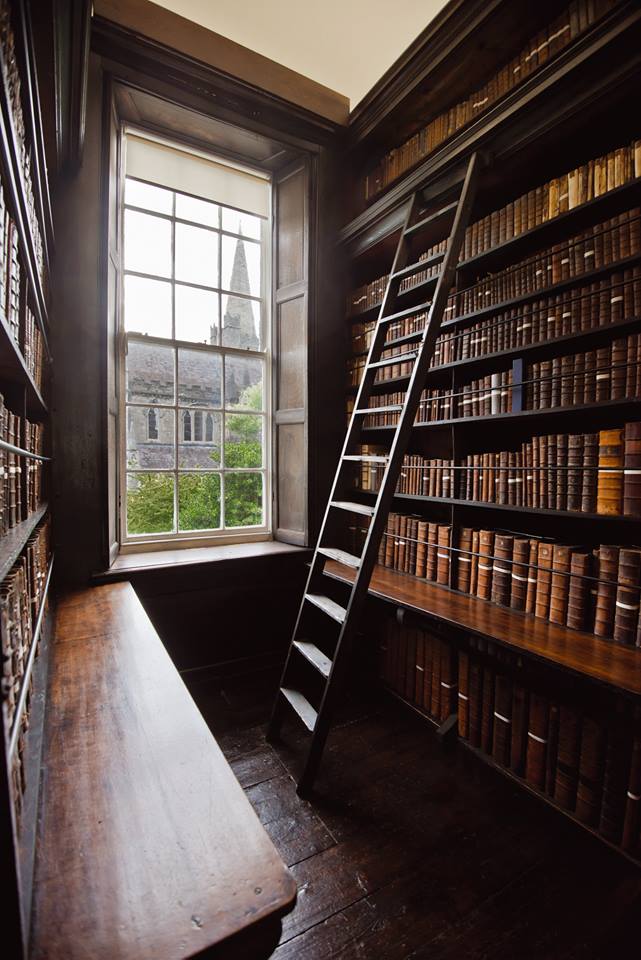誰でも子供の頃、絵本で読んだことのあるお話しだと思います。
では、その「ガリバー旅行記」を書いたのはアイルランド人であるのはご存知でしたか?
「ガリバー旅行記」を書いたのはジョナサン・スウィフト。17世紀に生きた作家であり、司祭でもある人です。
旧アイルランド紙幣にも印刷されているアイルランドを代表する人物です。
実はこの人物、作品を通してもちろん当時の人々に大きな影響を与えましたが、時空を超えて現代の日本文化にも影響を与え、その結果今度は世界中の人が彼の空想の国をビジュアルで鑑賞することになるとは、彼も思いもよらなかったことでしょう。。
「ガリバー旅行記」の中で、17世紀の日本の様子が紹介されています。
作者スウィフトは船医のガリバーをいろいろな空想の国へ旅立たせましたが、その中で唯一の実在する国は日本だけ。
スウィフトは17世紀、当時のヨーロッパ人達の「憧れのジパング」熱に更に火をつけ(小泉八雲も読んでいたようですね。後述のNさんのレポートで出てきます。)
今日では、宮崎駿のラピュタがきっかけで「ガリバー旅行記」にたどり着き、アイルランドを訪れるという逆のパターンも出て来て。。。
スウィフトさん、思いがけず、ヨーロッパやアイルランドと日本を繋ぐ不思議な役割を担いました。。
原典は、ジョージ・A・エイトケンによる『ステラへの消息』の序文その他から引用。
スウィフトは彼自身の墓碑銘を書き、それをウィリアム・バトラー・イェーツはラテン語から翻訳。
Hic depositum est corpus
JONATHAN SWIFT S.T.D.
Huyus Ecclesiae Cathedralis
Decani
Ubi saeva indignatio
Ulterius
Cor lacerare nequit
Abi Viator
Et imitare, si poteris
Strenuum pro virili
Libertatis Vindicatorem
イェーツの翻訳
Swift has sailed into his rest.
Savage indignation there
cannot lacerate his breast.
Imitate him if you can,
world-besotted traveller.
He served human liberty.
日本語訳
スウィフトは休息に入った。
そこでは激しい憤怒に
胸を切り裂かれることもない。
もしできることなら彼を真似てくれ、
世界に夢中になっている旅人よ、
人間の自由のために尽したこの男を。
そしてその脇にある小さな図書館でこのほど、日本に関する書物が多く見つかりました。
小さな図書館ですが、パトリック大聖堂の大主教ナルキッソス・マーシュが開設したアイルランド最古の公立図書館という大変由緒ある図書館で「マーシュ図書館」といいます。門構えはかわいらしい感じですが、中に入ると皮張りの古い本がずらりと並び、その重厚さに圧倒されます。
今回発見されたのは、16-18世紀のヨーロッパ人(イギリス人,オランダ人の修道士,地図作成家など)が作成した日本に関する書簡集や地図で、ヨーロッパ人が書いた日本地図では最古レベルのものらしいです。
今回の発見を記念して、4月に研究発表(以下にレポートあり)があり、また6月14日まではそれらの文献が展示されており、間近で見ることもできます。
今回ガリバー旅行記いろいろも含めて日本大使館の方にたくさんご教示いただきました。
「展示の見どころは特に地図に関しては,年を追うごとに,多くの欧州人にとって空想の国に等しかった日本への理解がだんだん深まっていく様子を俯瞰できるよう包括的に展示しているところ」だそうです。
世紀の発見、一度お蔵入りしたら、またすぐ見られないかもしれません。機会があったら是非見に行ってみてください!
マーシュ図書館はダブリンの中心部に位置し、啓蒙時代初期の蔵書が保存されています。
アイルランドの最初の公共図書館として1707年にオープンしました。
`Imagining Japan, 1570-1750`
`Imagining Japan, 1570-1750`
ヨーロッパが初めて日本とコンタクトを持った当時を知るまたとない機会
日本を描いた珍しい初期の地図の数々を展示。
手書きで色塗りされた,ヨハン・ブラウ(Joan Blaeu)のアトラス・マイヨール(Atlas Maior)日本地図1662年は必見。
ジョナサン・スウィフトのガリバー旅行記に代表されるようこの時代の人々がいかに未知の国としての日本に惹かれ影響を受けたか・・
場所:Marsh’s Library, St Patrick’s Close, Dublin 8(セント·パトリック大聖堂横)
期間: 2014年4月14日から6月14日まで
営業時間:月、水、木、金 9:30-5:00
土10:00-5:00
閉館:火、日
Our new exhibition was launched on Monday, the 14th of April by His Excellency, Mr Chihiro Atsumi, Ambassador of Japan to Ireland.
He and his wife first attended an opening public lecture by Dr Declan Downey of UCD on ‘First Impressions of Japan: Image and Reality’ which looked at early European representations of Japan and her people.
Almost 100 people crammed into the galleries in Marsh’s Library to see the new exhibition, which includes the beautiful hand-coloured Blaeu map of Japan (1662), and a 1587 map of Japan by Abraham Ortelius which is decorated with mermaids and sea monsters.
The exhibition will run until 14 June, and bookings for group tours are welcome.
Photo: Embassy of Japan
さて、`Imaging Japan` の展示の初日に展示の書物、地図についてマーシュ図書館で講演がありました。
その内容をゴールウェイ大学に留学中で英文学を勉強しているNさんがレポートにまとめてくれたので、以下に紹介します。
……………………………………………………………………………………………………………………………
Dr Downey’s lecture
First Impressions of Japan in Europe: Image and Reality
“Experience Japan”関連イベントとして、4月14日~6月14日の日程でダブリンのMarsh’s Libraryにおいて16世紀から18世紀にヨーロッパで用いられた日本の地図の展示が行われています。その展示に関連し、Dr Downeyによるヨーロッパにおける日本に関する記述についての講演が行われました。この図書館は聖パトリック大聖堂に隣接しており、ここにはガリバー旅行記(1726年刊)の作者として知られるジョナサン・スウィフト(1667-1745)が埋葬されています。ガリバー旅行記には日本が地図上の指標として、また物語における架空の国の中に混じって登場しますが、スウィフトは西洋での東洋研究から得られた情報を参考に小人の国リリパットを構想したと考えられています。19世紀の作家、小泉八雲の日本名で知られるラフカディオ・ハーン(1850-1904)が著作『知られざる日本の面影』(1894)の中で日本とリリパッドを関連付けるなど、彼の作品は後世にも影響を残しています。今回の講演ではスウィフトの時代を含むヨーロッパで日本という国がどのように理解されてきたのか、彼らの目に映った日本・日本人とはどのような姿だったのかが紹介されました。
西洋における日本に関する記述は16世紀中頃、ポルトガル人が来日したころから記されてきました。マルコ・ポーロ(1254-1324)の『東方見聞録』はそれに先立ちますが、これは実際に日本に滞在したうえでの記述ではなく、日本留学経験のある中国人並びに中国留学中の日本人から聞き知ったことを書き記したものであり、日本滞在体験を持つ西洋人による初期の記録としてはポルトガル人宣教師ルイス・フロイス(1532-97)によ『日本史』や、オランダ商館長フランソワ・カロン(1600-1673)の『日本大王国志』などが挙げられます。
このころの日本の印象として、「いかなる他国の支配も受けていないこと」や「地理的な要因による孤立性」などが繰り返し記されています。イエズス会士フランシスコ・ザビエル(1506-1552)は日本人を「気位が高く」、「外国人を軽視」し「好戦的」と記していますが、戦国期であったことを考えると当然の印象と思われます。前述のカロンは日本人が「物質主義を嫌悪」しているとし、富の過少に関わりなく商人の地位が低いことに言及しています。またイエズス会士ヴァリニャーノ(1539-1606)は切腹の作法について書き記していますが、19世紀の開国後、イギリスの外交官であるサトウやリーズデールの記録にも類似の描写があり、200年以上の不変性が見受けられます。
西洋において鎖国中の日本に関する知識は専らオランダを介するようになりますが、スペイン・ポルトガルからは高い需要があったようです。特に植物に関する情報が多く集められましたが、これは植物の医学的利用への関心が高かったこと、またスウェーデン人博物学者カール・フォン・リンネ(1707-1778)が生物の分類法を確立したことから植物採集とその分類が各地で盛んに行われていたことがその理由と考えられます。代表的な研究はシーボルト事件で知られるフィリップ・フランツ・フォン・シーボルト(179-1866)による『日本植物誌』が挙げられます。こうした科学的関心と異国への興味が重なり、西洋において東洋に対する興味関心が高まっている中で、ジョナサン・スウィフトは東洋に関する本や研究などから『ガリバー旅行記』の小人の国リリパットのアイディアを得たようです。その他には音楽や生け花、茶会などの文化や漆・扇子などの日用品など日本に関する記述は多岐にわたっており、その多くは19世紀以降、また現代の日本でも見受けられます。時代に伴い様々な変化を経てはいるでしょうが、過去から連綿と続く日本の姿の一部を知るためにもこれらの記録は非常に価値のあるものだと思います。
Dr Downeyの講演では文字媒体での記述から西洋人の見た日本の姿を探りましたがMarsh’s Libraryの展示では地図からヨーロッパにおける日本の姿を窺い知ることができます。”Imagining Japan”と題されていることからも正確とは言い難い日本の姿かもしれませんが、日本がヨーロッパにとって未知の国だった時代、そして鎖国政策によって情報や交流がごく限られていた時代に日本がどのように捉えられていたのか、興味深い資料を閲覧する貴重な機会ですのでぜひ足を運んでみてはいかがでしょうか。
末筆ながらご協力をいただいた、大使館の文化担当官、ゴールウェイ大学のNさんに御礼申し上げます。
さぁ、今日も元気にまいりましょう♪
Photo Courtesy:YOSHIMI HAYAKAWA
(アイルランド共和国現地 5/18ゴールウェイ電)
Ireland Finest Moments
Courtesy of Swift Satire Festival Community
The Swift Satire Festival, Trim, held for the sixth time in July 2013, celebrates the life, works, wit and satire of Jonathan Swift and his close connections with Trim, Co Meath, Ireland which began when he was appointed vicar of Laracor on the outskirts of the town in 1700. It aims to promote satire in Ireland and attracts people from all over the world!
About the Festival
Every year, we celebrate the life and works of a strange and enigmatic satirist called Jonathan Swift.
Swift lived in Trim for an important part of his life as Dean of Laracor. Whilst living here, he wrote some of the world’s most famous satires. From his elegant house in Trim, he changed the world, created new worlds, brought down Governments and pointed out the injustices of the time through his satire.
We celebrate this every year.
We try to emulate Swift’s achievements by giving satirists a platform to hold a mirror up to society.
This is more fun than it sounds because each year we bring together the funniest, most opinionated, grouchy, insightful, dynamic and out-there personalities from Ireland and further afield to celebrate satire.
We think the Dean would approve.
This is a unique festival; no other festival in the world is dedicated to Satire (apart from one in Iran).
About Swift
Jonathan Swift, Poet, satirist, man of religion and politics, Jonathan Swift (1667-1745) was a master of scathing satire and political wit. His most famous satirical writings are A Tale of a Tub (1704), Gulliver’s Travels (1725), and A Modest Proposal (1729).
Swift wrote his own epitaph in which he speaks of his ‘savage indignation’ and defies future generations to surpass his defence of liberty. Swift’s writing remains a byword for absurd humour, acute political insight, grotesque imagination, and lacerating wit.
Here is the Idiot’s Guide to Swift….
6½ things you never knew you wanted to know about Jonathan Swift
1.The book universally known as Gulliver’s Travels was first published under the title Travels into Several Remote Nations of the World, in Four Parts. By Lemuel Gulliver, First a Surgeon, and then a Captain of Several Ships. Most were quick to realize that it was not a genuine traveller’s tale but work of fiction by Swift, although a bishop at the time is supposed to have proudly announced that he believed less than half of what he read.
2.As well as giving rise to the name ‘yahoo’ for a lout or hooligan, Swift invented the personal name Vanessa and coined the term ‘sweetness and light’.
3.Part three of Gulliver’s Travels describes the planet Mars as having two moons. It does – but they were not discovered until 1877, 150 years after Swift’s book.
4.Swift was unusually clean by the standards of his day. Not alone did he regularly change his shirt and underclothes, he favoured washing with soap and water over the more conventional approach of using perfume to disguise the odour of one’s unwashed body.
5.Legend has it that Swift and Stella were buried together. They were – but only 90 years after Swift’s death and then only from the neck up. In 1835 alterations to St Patrick’s Cathedral uncovered the separate graves of Swift and Stella. Phrenologists at a visiting conference were given permission to examine the skulls which were then re-interred together.
6.Swift left money in his will to found a psychiatric hospital, to be located ‘in any Province of Ireland, except Connaught’ . St Patrick’s University Hospital, Dublin is now Ireland’s largest mental health service provider.
6½.Swift became so frustrated with the arduous journey between Dublin and London that he expressed a desire to be buried halfway between the two at Holyhead.




















